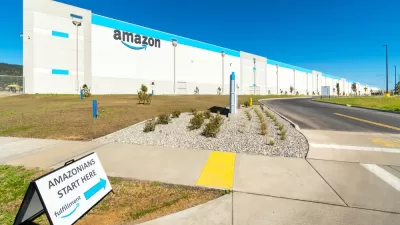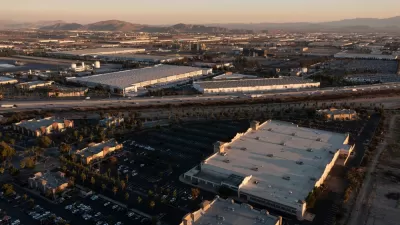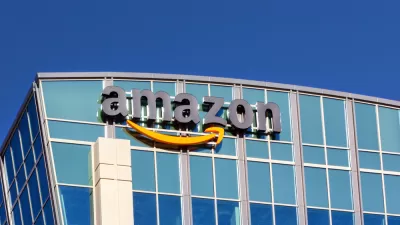The e-commerce giant has been quietly buying up massive swaths of property as the company works to reduce shipping times as dramatically as possible.

A Bloomberg article by Spencer Soper and Natalie Wong explains the growth of Amazon’s real estate holdings. “Starting about three years ago, the Seattle-based colossus quietly began searching for property in key US markets such as Southern California, Texas, Illinois, Florida and the Bay Area. Between 2020 and 2022, Amazon tripled the amount of built industrial space it owns in North America, according to company filings.”
As the authors note, “It’s a potentially risky strategy that exposes Amazon to the vagaries of the industrial real estate market. The company also overbuilt during the pandemic and is saddled with too much warehouse space now that the surge in online shopping has decelerated.” Yet “Executives remain committed to securing land in the right locations to fulfill founder Jeff Bezos’ vision of making an online purchase as instantly gratifying as a trip to the store.”
However, “Buying land is risky. Developing it is even more so because Amazon itself must negotiate the local bureaucracy and politics. But executives feel they have no choice, according to people familiar with the strategy, because the new generation of fulfillment centers are several orders of magnitude more complicated than the 40-foot boxes currently dotted around the country.”
According to the article, the company is already hedging its bets, slowing down their plans as online sales slow and a recession looms on the horizon. “The question now is how Amazon will adapt a boom-era strategy to current economic conditions.”
FULL STORY: Amazon Builds Property Empire, Quietly Buying Land Across the US

Planetizen Federal Action Tracker
A weekly monitor of how Trump’s orders and actions are impacting planners and planning in America.

Chicago’s Ghost Rails
Just beneath the surface of the modern city lie the remnants of its expansive early 20th-century streetcar system.

San Antonio and Austin are Fusing Into one Massive Megaregion
The region spanning the two central Texas cities is growing fast, posing challenges for local infrastructure and water supplies.

Since Zion's Shuttles Went Electric “The Smog is Gone”
Visitors to Zion National Park can enjoy the canyon via the nation’s first fully electric park shuttle system.

Trump Distributing DOT Safety Funds at 1/10 Rate of Biden
Funds for Safe Streets and other transportation safety and equity programs are being held up by administrative reviews and conflicts with the Trump administration’s priorities.

German Cities Subsidize Taxis for Women Amid Wave of Violence
Free or low-cost taxi rides can help women navigate cities more safely, but critics say the programs don't address the root causes of violence against women.
Urban Design for Planners 1: Software Tools
This six-course series explores essential urban design concepts using open source software and equips planners with the tools they need to participate fully in the urban design process.
Planning for Universal Design
Learn the tools for implementing Universal Design in planning regulations.
planning NEXT
Appalachian Highlands Housing Partners
Mpact (founded as Rail~Volution)
City of Camden Redevelopment Agency
City of Astoria
City of Portland
City of Laramie





























